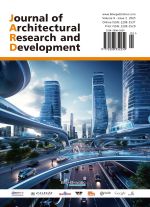Abstract
By adding zeolite aggregate with good adsorption properties, different mix ratios of added zeolite pervious concrete (ZPC) were designed to compare the water purification effect of ordinary pervious concrete and water purification tests that were conducted. The pore characteristics of the pervious concrete were identified using three-dimensional reconstruction software and the relationship between pore structure and water purification performance was quantified by gray entropy correlation analysis. The results showed that the purification efficiency of zeolite-doped pervious concrete was 17.6%–22.3% higher than that of ordinary pervious concrete. The characteristic parameters of the pore structure of permeable concrete, i.e. planar porosity and tortuosity, were determined using three-dimensional reconstruction software. The correlation between the degree of tortuosity and the removal rate reached more than 0.90, indicating that the internal pore structure of pervious concrete has a good correlation with the water purification performance.
References
Azad A, Saeedian A, Mousavi SF, et al., 2020, Effect Of Zeolite And Pumice Powders On The Environmental And Physical Characteristics Of Green Concrete Filters. Construction And Building Materials, 240: 117931.
Kurtay M, Gerengi H, Kocak Y, et al., 2020, The Potency Of Zeolite And Diatomite On The Corrosive Destruction Of Reinforcing Steel In 1 M HNO3 Environment. Construction And Building Materials, 236(3): 117572.
Yang S, Guo M, Duan S, et al., 2019, Study On Strength Variation Of Permeable Concrete Based On Differential Calorimetry Method And Multi-Index Test. Advances In Materials Science And Engineering, 2019(9): 1–9.
Jia J, Yu Y, Guo Y, et al., 2021, Study On Composition Design Of Water-Purifying Functional Pervious Concrete. Bulletin Of The Chinese Ceramic Society, 40(08): 2554–2563.
Shang H, Sun Z, 2019, PAHs (Naphthalene) Removal From Stormwater Runoff By Organoclay Amended Pervious Concrete. Construction And Building Materials, 200: 170–180.
Yousefi A, Matavos-Aramyan S, 2018, Mix Design Optimization Of Silica Fume-Based Pervious Concrete For Removal Of Heavy Metals From Wastewaters. Silicon, 10(4): 1737–1744.
Zhang J, Ma G, Ming R, et al., 2018, Numerical Study On Seepage Flow In Pervious Concrete Based On 3D CT Imaging. Construction And Building Materials, 161: 468–478.
Zhou H, Li H, Abdelhady A, et al., 2019, Experimental Investigation On The Effect Of Pore Characteristics On Clogging Risk Of Pervious Concrete Based On CT Scanning. Construction And Building Materials, 212: 130–139.
Wang Y, Tan J, Li W, et al., 2024, Quantitative Relationship Model Research Between Pore Characteristic And Permeability Coefficient Of Permeable Pavement Brick. Journal Of Building Materials, 27(02): 174–180.
Liu S, Chen X, Li S, et al., 2021, Mesoscopic Structure Analysis Of Recycled Aggregate Ecological Porous Concrete Based On CT. Water Resources And Hydropower Engineering, 52(02): 174–183.
Liu J, Li Y, 2020, Runoff Purification Effects Of Permeable Concrete Modified By Diatomite And Zeolite Powder. Advances In Materials Science And Engineering, 2020(2): 1–11.
Sudagar AJ, Andrejkovicova S, Rocha F, et al., 2023, Compressive Strength And Heavy Metal Adsorption Of Cork Residue, Natural Zeolite, And Low-Grade Metakaolin-Based Geopolymers. Construction And Building Materials, 366: 130125.
Teymouri E, Wong KS, Tan YY, et al., 2023, Mechanical Behaviour Of Adsorbent Pervious Concrete Using Iron Slag And Zeolite As Coarse Aggregates. Construction And Building Materials, 388: 131720.
She X, Chen J, 2021, Research Progress On Preparation And Properties Of Zeolite Porous Concrete. New Building Materials, 48(10): 75–79 + 99.
